Business Structure, Finance, and HR Policies for Startups
VerifiedAdded on 2022/11/25
|11
|4021
|1
Report
AI Summary
This report provides a comprehensive analysis of the crucial elements for a successful startup. It begins by exploring various business legal structures, such as sole proprietorship, partnership, and limited liability companies, detailing their strengths and weaknesses. The report then delves into different sources of raising finance, including owner funding, crowdfunding, and bank loans, evaluating their benefits and limitations. Furthermore, it identifies and explains the various sectors of the economy, namely primary, secondary, and tertiary sectors, discussing their significance. Finally, the report examines Human Resource policies, focusing on equality and diversity, as well as health and safety, highlighting their importance in the workplace. The report aims to provide a detailed overview of the factors essential for planning and launching a successful startup.
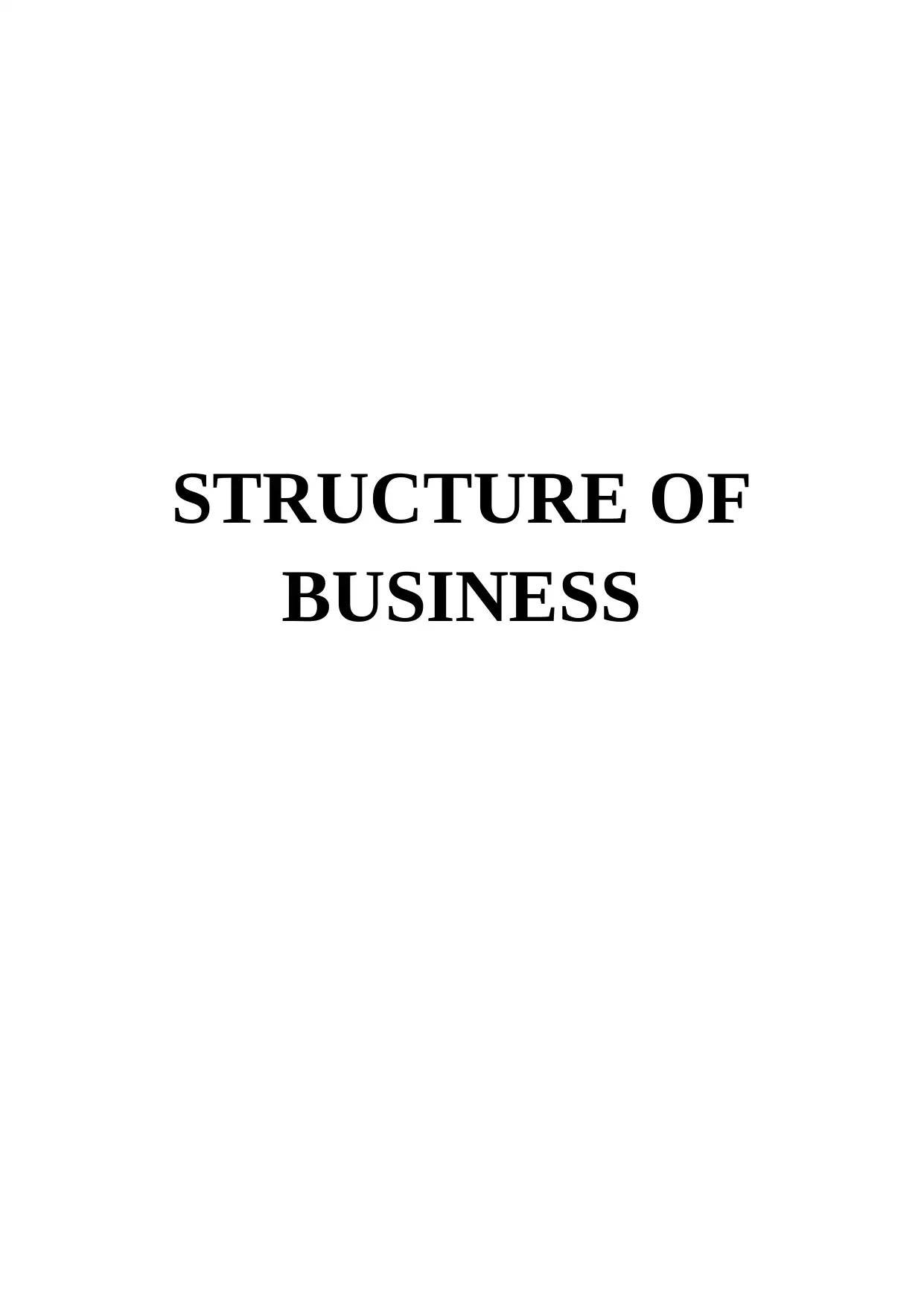
STRUCTURE OF
BUSINESS
BUSINESS
Paraphrase This Document
Need a fresh take? Get an instant paraphrase of this document with our AI Paraphraser
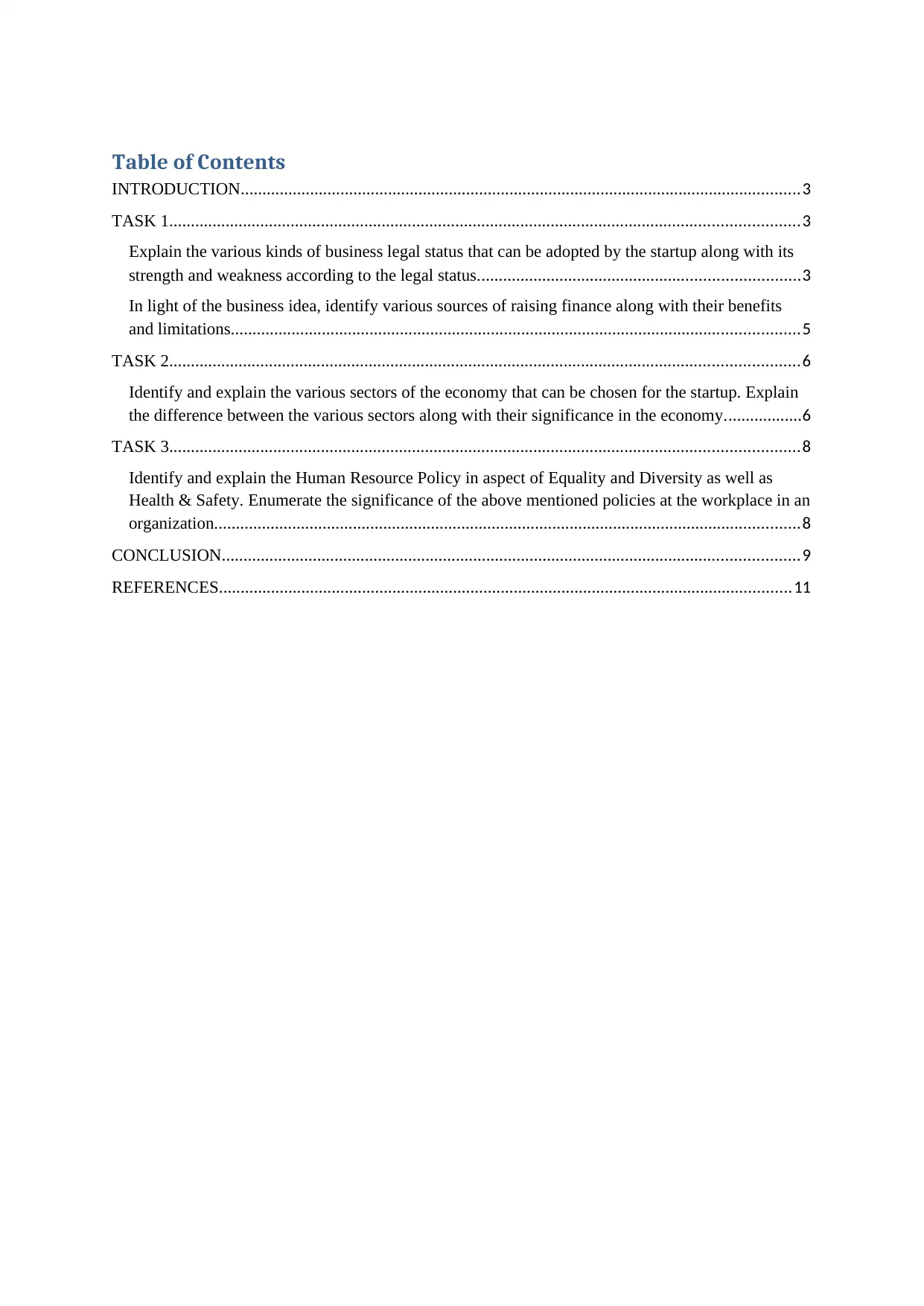
Table of Contents
INTRODUCTION.................................................................................................................................3
TASK 1.................................................................................................................................................3
Explain the various kinds of business legal status that can be adopted by the startup along with its
strength and weakness according to the legal status..........................................................................3
In light of the business idea, identify various sources of raising finance along with their benefits
and limitations...................................................................................................................................5
TASK 2.................................................................................................................................................6
Identify and explain the various sectors of the economy that can be chosen for the startup. Explain
the difference between the various sectors along with their significance in the economy..................6
TASK 3.................................................................................................................................................8
Identify and explain the Human Resource Policy in aspect of Equality and Diversity as well as
Health & Safety. Enumerate the significance of the above mentioned policies at the workplace in an
organization.......................................................................................................................................8
CONCLUSION.....................................................................................................................................9
REFERENCES....................................................................................................................................11
INTRODUCTION.................................................................................................................................3
TASK 1.................................................................................................................................................3
Explain the various kinds of business legal status that can be adopted by the startup along with its
strength and weakness according to the legal status..........................................................................3
In light of the business idea, identify various sources of raising finance along with their benefits
and limitations...................................................................................................................................5
TASK 2.................................................................................................................................................6
Identify and explain the various sectors of the economy that can be chosen for the startup. Explain
the difference between the various sectors along with their significance in the economy..................6
TASK 3.................................................................................................................................................8
Identify and explain the Human Resource Policy in aspect of Equality and Diversity as well as
Health & Safety. Enumerate the significance of the above mentioned policies at the workplace in an
organization.......................................................................................................................................8
CONCLUSION.....................................................................................................................................9
REFERENCES....................................................................................................................................11
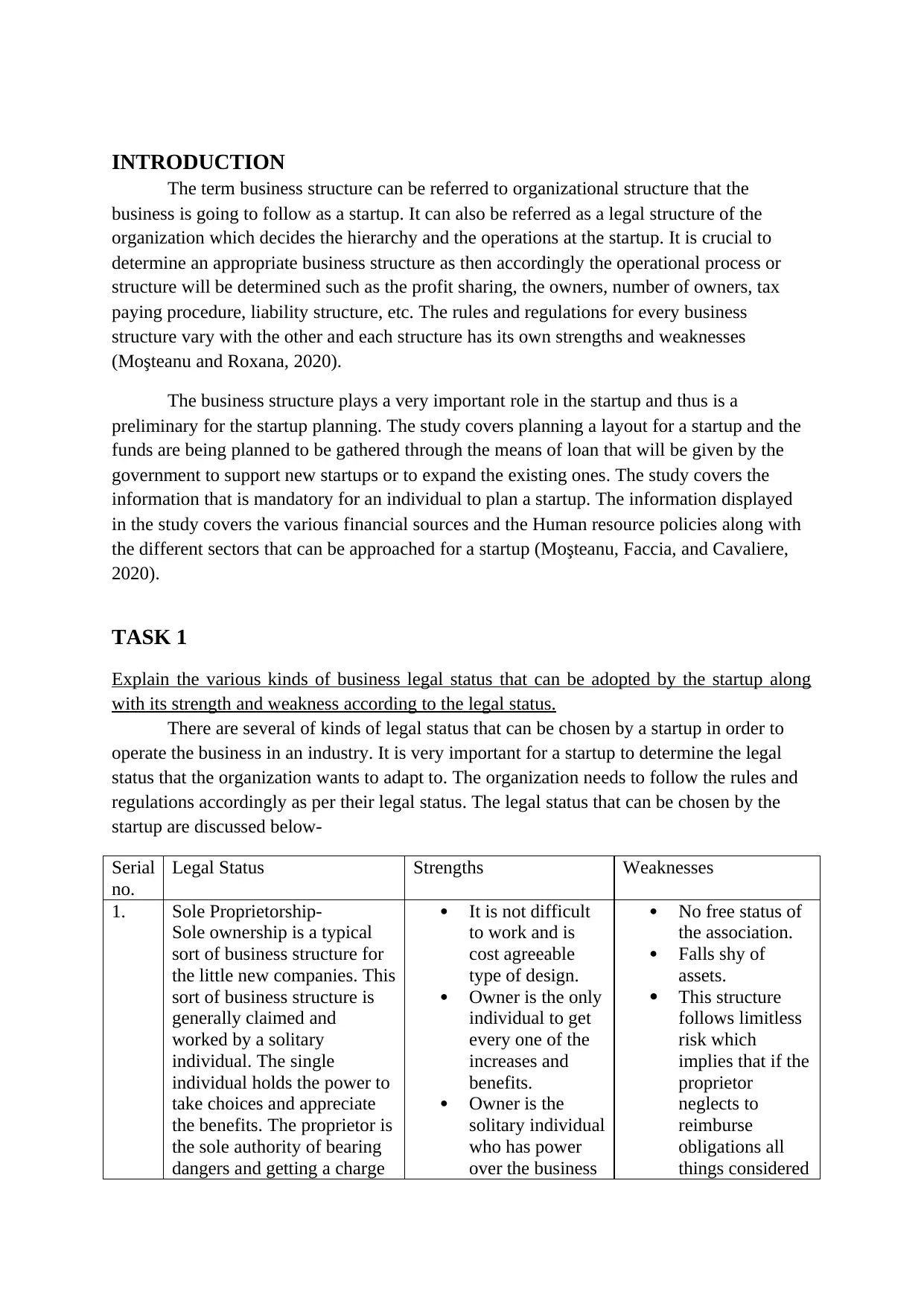
INTRODUCTION
The term business structure can be referred to organizational structure that the
business is going to follow as a startup. It can also be referred as a legal structure of the
organization which decides the hierarchy and the operations at the startup. It is crucial to
determine an appropriate business structure as then accordingly the operational process or
structure will be determined such as the profit sharing, the owners, number of owners, tax
paying procedure, liability structure, etc. The rules and regulations for every business
structure vary with the other and each structure has its own strengths and weaknesses
(Moşteanu and Roxana, 2020).
The business structure plays a very important role in the startup and thus is a
preliminary for the startup planning. The study covers planning a layout for a startup and the
funds are being planned to be gathered through the means of loan that will be given by the
government to support new startups or to expand the existing ones. The study covers the
information that is mandatory for an individual to plan a startup. The information displayed
in the study covers the various financial sources and the Human resource policies along with
the different sectors that can be approached for a startup (Moşteanu, Faccia, and Cavaliere,
2020).
TASK 1
Explain the various kinds of business legal status that can be adopted by the startup along
with its strength and weakness according to the legal status.
There are several of kinds of legal status that can be chosen by a startup in order to
operate the business in an industry. It is very important for a startup to determine the legal
status that the organization wants to adapt to. The organization needs to follow the rules and
regulations accordingly as per their legal status. The legal status that can be chosen by the
startup are discussed below-
Serial
no.
Legal Status Strengths Weaknesses
1. Sole Proprietorship-
Sole ownership is a typical
sort of business structure for
the little new companies. This
sort of business structure is
generally claimed and
worked by a solitary
individual. The single
individual holds the power to
take choices and appreciate
the benefits. The proprietor is
the sole authority of bearing
dangers and getting a charge
It is not difficult
to work and is
cost agreeable
type of design.
Owner is the only
individual to get
every one of the
increases and
benefits.
Owner is the
solitary individual
who has power
over the business
No free status of
the association.
Falls shy of
assets.
This structure
follows limitless
risk which
implies that if the
proprietor
neglects to
reimburse
obligations all
things considered
The term business structure can be referred to organizational structure that the
business is going to follow as a startup. It can also be referred as a legal structure of the
organization which decides the hierarchy and the operations at the startup. It is crucial to
determine an appropriate business structure as then accordingly the operational process or
structure will be determined such as the profit sharing, the owners, number of owners, tax
paying procedure, liability structure, etc. The rules and regulations for every business
structure vary with the other and each structure has its own strengths and weaknesses
(Moşteanu and Roxana, 2020).
The business structure plays a very important role in the startup and thus is a
preliminary for the startup planning. The study covers planning a layout for a startup and the
funds are being planned to be gathered through the means of loan that will be given by the
government to support new startups or to expand the existing ones. The study covers the
information that is mandatory for an individual to plan a startup. The information displayed
in the study covers the various financial sources and the Human resource policies along with
the different sectors that can be approached for a startup (Moşteanu, Faccia, and Cavaliere,
2020).
TASK 1
Explain the various kinds of business legal status that can be adopted by the startup along
with its strength and weakness according to the legal status.
There are several of kinds of legal status that can be chosen by a startup in order to
operate the business in an industry. It is very important for a startup to determine the legal
status that the organization wants to adapt to. The organization needs to follow the rules and
regulations accordingly as per their legal status. The legal status that can be chosen by the
startup are discussed below-
Serial
no.
Legal Status Strengths Weaknesses
1. Sole Proprietorship-
Sole ownership is a typical
sort of business structure for
the little new companies. This
sort of business structure is
generally claimed and
worked by a solitary
individual. The single
individual holds the power to
take choices and appreciate
the benefits. The proprietor is
the sole authority of bearing
dangers and getting a charge
It is not difficult
to work and is
cost agreeable
type of design.
Owner is the only
individual to get
every one of the
increases and
benefits.
Owner is the
solitary individual
who has power
over the business
No free status of
the association.
Falls shy of
assets.
This structure
follows limitless
risk which
implies that if the
proprietor
neglects to
reimburse
obligations all
things considered
⊘ This is a preview!⊘
Do you want full access?
Subscribe today to unlock all pages.

Trusted by 1+ million students worldwide
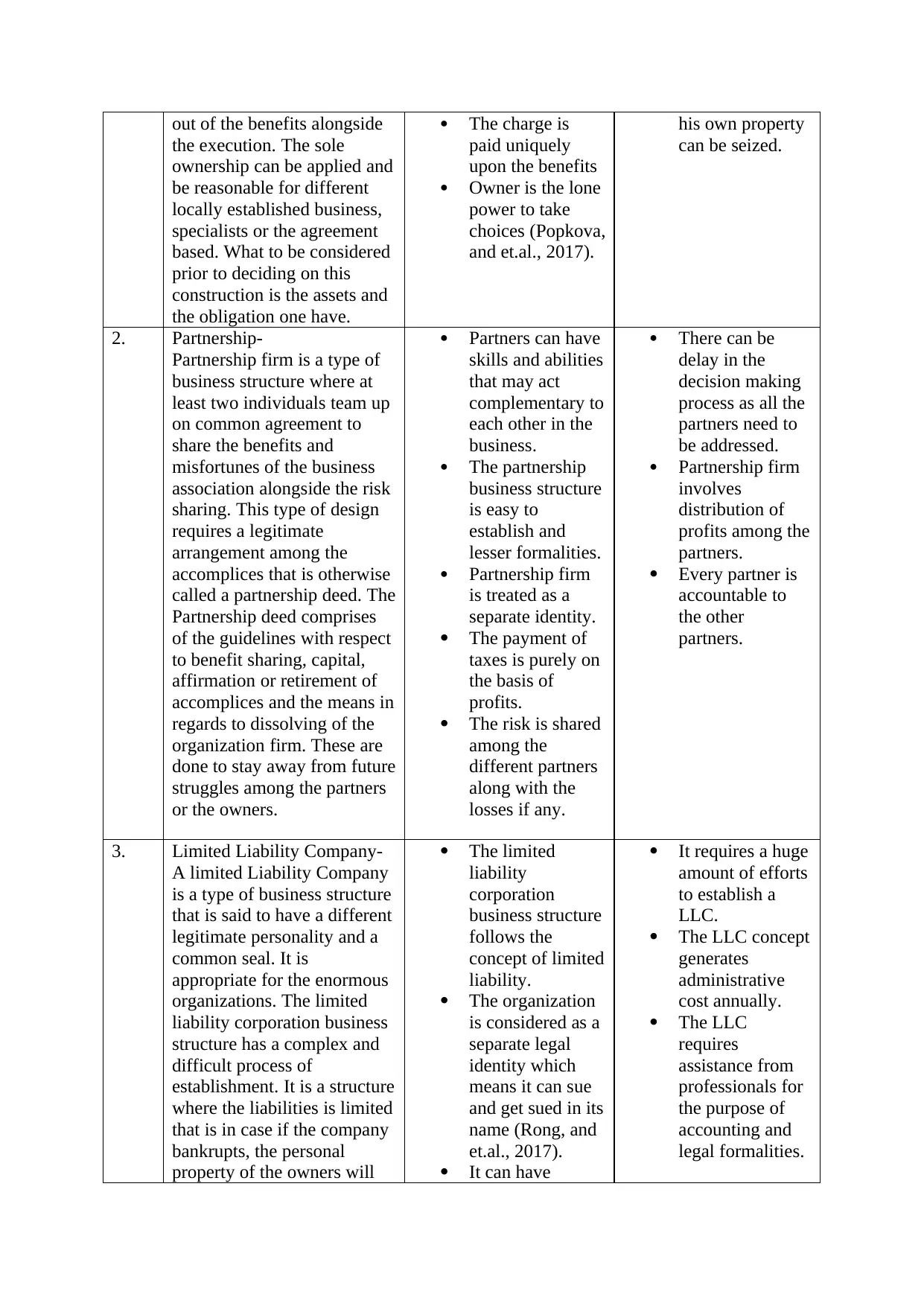
out of the benefits alongside
the execution. The sole
ownership can be applied and
be reasonable for different
locally established business,
specialists or the agreement
based. What to be considered
prior to deciding on this
construction is the assets and
the obligation one have.
The charge is
paid uniquely
upon the benefits
Owner is the lone
power to take
choices (Popkova,
and et.al., 2017).
his own property
can be seized.
2. Partnership-
Partnership firm is a type of
business structure where at
least two individuals team up
on common agreement to
share the benefits and
misfortunes of the business
association alongside the risk
sharing. This type of design
requires a legitimate
arrangement among the
accomplices that is otherwise
called a partnership deed. The
Partnership deed comprises
of the guidelines with respect
to benefit sharing, capital,
affirmation or retirement of
accomplices and the means in
regards to dissolving of the
organization firm. These are
done to stay away from future
struggles among the partners
or the owners.
Partners can have
skills and abilities
that may act
complementary to
each other in the
business.
The partnership
business structure
is easy to
establish and
lesser formalities.
Partnership firm
is treated as a
separate identity.
The payment of
taxes is purely on
the basis of
profits.
The risk is shared
among the
different partners
along with the
losses if any.
There can be
delay in the
decision making
process as all the
partners need to
be addressed.
Partnership firm
involves
distribution of
profits among the
partners.
Every partner is
accountable to
the other
partners.
3. Limited Liability Company-
A limited Liability Company
is a type of business structure
that is said to have a different
legitimate personality and a
common seal. It is
appropriate for the enormous
organizations. The limited
liability corporation business
structure has a complex and
difficult process of
establishment. It is a structure
where the liabilities is limited
that is in case if the company
bankrupts, the personal
property of the owners will
The limited
liability
corporation
business structure
follows the
concept of limited
liability.
The organization
is considered as a
separate legal
identity which
means it can sue
and get sued in its
name (Rong, and
et.al., 2017).
It can have
It requires a huge
amount of efforts
to establish a
LLC.
The LLC concept
generates
administrative
cost annually.
The LLC
requires
assistance from
professionals for
the purpose of
accounting and
legal formalities.
the execution. The sole
ownership can be applied and
be reasonable for different
locally established business,
specialists or the agreement
based. What to be considered
prior to deciding on this
construction is the assets and
the obligation one have.
The charge is
paid uniquely
upon the benefits
Owner is the lone
power to take
choices (Popkova,
and et.al., 2017).
his own property
can be seized.
2. Partnership-
Partnership firm is a type of
business structure where at
least two individuals team up
on common agreement to
share the benefits and
misfortunes of the business
association alongside the risk
sharing. This type of design
requires a legitimate
arrangement among the
accomplices that is otherwise
called a partnership deed. The
Partnership deed comprises
of the guidelines with respect
to benefit sharing, capital,
affirmation or retirement of
accomplices and the means in
regards to dissolving of the
organization firm. These are
done to stay away from future
struggles among the partners
or the owners.
Partners can have
skills and abilities
that may act
complementary to
each other in the
business.
The partnership
business structure
is easy to
establish and
lesser formalities.
Partnership firm
is treated as a
separate identity.
The payment of
taxes is purely on
the basis of
profits.
The risk is shared
among the
different partners
along with the
losses if any.
There can be
delay in the
decision making
process as all the
partners need to
be addressed.
Partnership firm
involves
distribution of
profits among the
partners.
Every partner is
accountable to
the other
partners.
3. Limited Liability Company-
A limited Liability Company
is a type of business structure
that is said to have a different
legitimate personality and a
common seal. It is
appropriate for the enormous
organizations. The limited
liability corporation business
structure has a complex and
difficult process of
establishment. It is a structure
where the liabilities is limited
that is in case if the company
bankrupts, the personal
property of the owners will
The limited
liability
corporation
business structure
follows the
concept of limited
liability.
The organization
is considered as a
separate legal
identity which
means it can sue
and get sued in its
name (Rong, and
et.al., 2017).
It can have
It requires a huge
amount of efforts
to establish a
LLC.
The LLC concept
generates
administrative
cost annually.
The LLC
requires
assistance from
professionals for
the purpose of
accounting and
legal formalities.
Paraphrase This Document
Need a fresh take? Get an instant paraphrase of this document with our AI Paraphraser
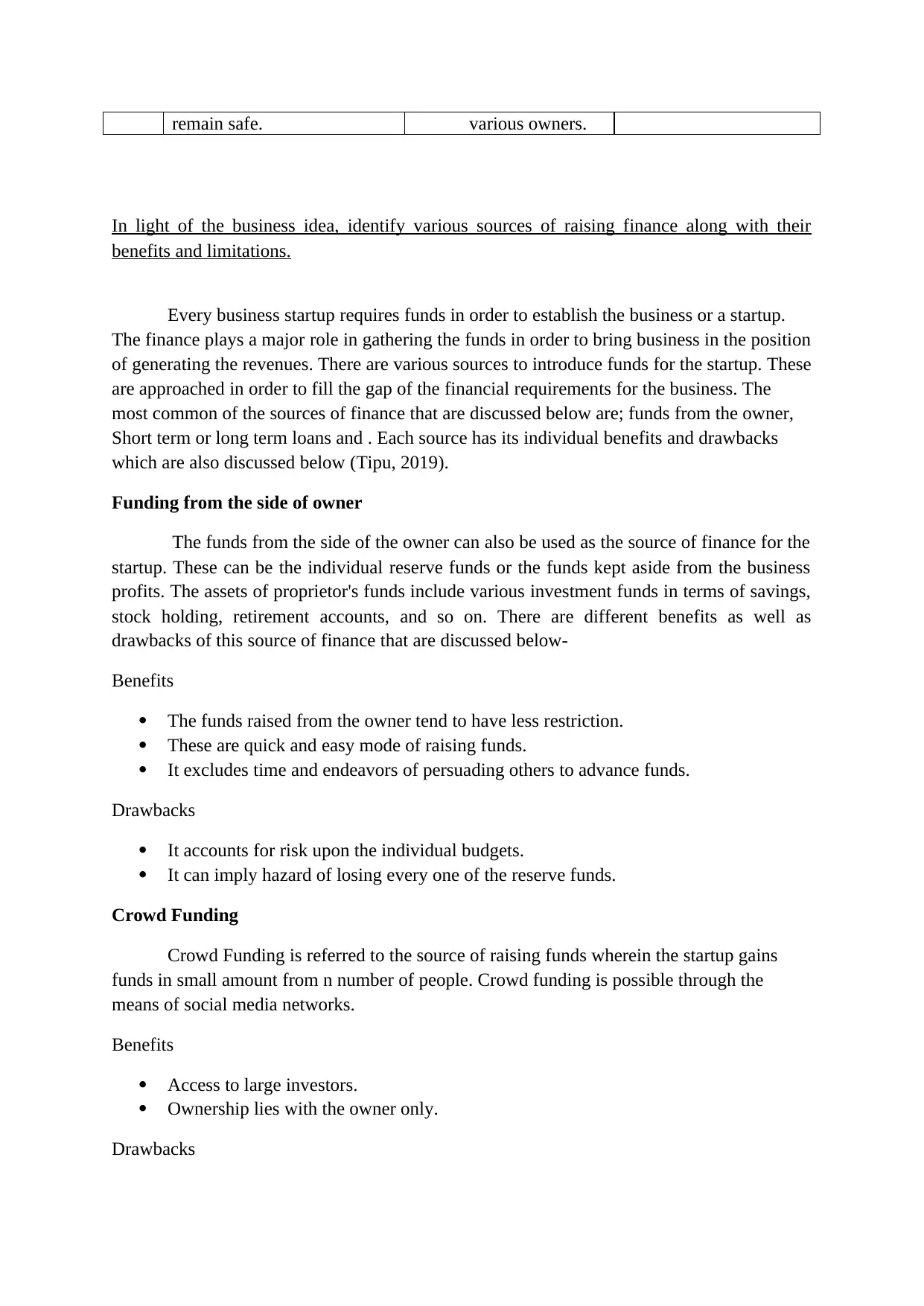
remain safe. various owners.
In light of the business idea, identify various sources of raising finance along with their
benefits and limitations.
Every business startup requires funds in order to establish the business or a startup.
The finance plays a major role in gathering the funds in order to bring business in the position
of generating the revenues. There are various sources to introduce funds for the startup. These
are approached in order to fill the gap of the financial requirements for the business. The
most common of the sources of finance that are discussed below are; funds from the owner,
Short term or long term loans and . Each source has its individual benefits and drawbacks
which are also discussed below (Tipu, 2019).
Funding from the side of owner
The funds from the side of the owner can also be used as the source of finance for the
startup. These can be the individual reserve funds or the funds kept aside from the business
profits. The assets of proprietor's funds include various investment funds in terms of savings,
stock holding, retirement accounts, and so on. There are different benefits as well as
drawbacks of this source of finance that are discussed below-
Benefits
The funds raised from the owner tend to have less restriction.
These are quick and easy mode of raising funds.
It excludes time and endeavors of persuading others to advance funds.
Drawbacks
It accounts for risk upon the individual budgets.
It can imply hazard of losing every one of the reserve funds.
Crowd Funding
Crowd Funding is referred to the source of raising funds wherein the startup gains
funds in small amount from n number of people. Crowd funding is possible through the
means of social media networks.
Benefits
Access to large investors.
Ownership lies with the owner only.
Drawbacks
In light of the business idea, identify various sources of raising finance along with their
benefits and limitations.
Every business startup requires funds in order to establish the business or a startup.
The finance plays a major role in gathering the funds in order to bring business in the position
of generating the revenues. There are various sources to introduce funds for the startup. These
are approached in order to fill the gap of the financial requirements for the business. The
most common of the sources of finance that are discussed below are; funds from the owner,
Short term or long term loans and . Each source has its individual benefits and drawbacks
which are also discussed below (Tipu, 2019).
Funding from the side of owner
The funds from the side of the owner can also be used as the source of finance for the
startup. These can be the individual reserve funds or the funds kept aside from the business
profits. The assets of proprietor's funds include various investment funds in terms of savings,
stock holding, retirement accounts, and so on. There are different benefits as well as
drawbacks of this source of finance that are discussed below-
Benefits
The funds raised from the owner tend to have less restriction.
These are quick and easy mode of raising funds.
It excludes time and endeavors of persuading others to advance funds.
Drawbacks
It accounts for risk upon the individual budgets.
It can imply hazard of losing every one of the reserve funds.
Crowd Funding
Crowd Funding is referred to the source of raising funds wherein the startup gains
funds in small amount from n number of people. Crowd funding is possible through the
means of social media networks.
Benefits
Access to large investors.
Ownership lies with the owner only.
Drawbacks
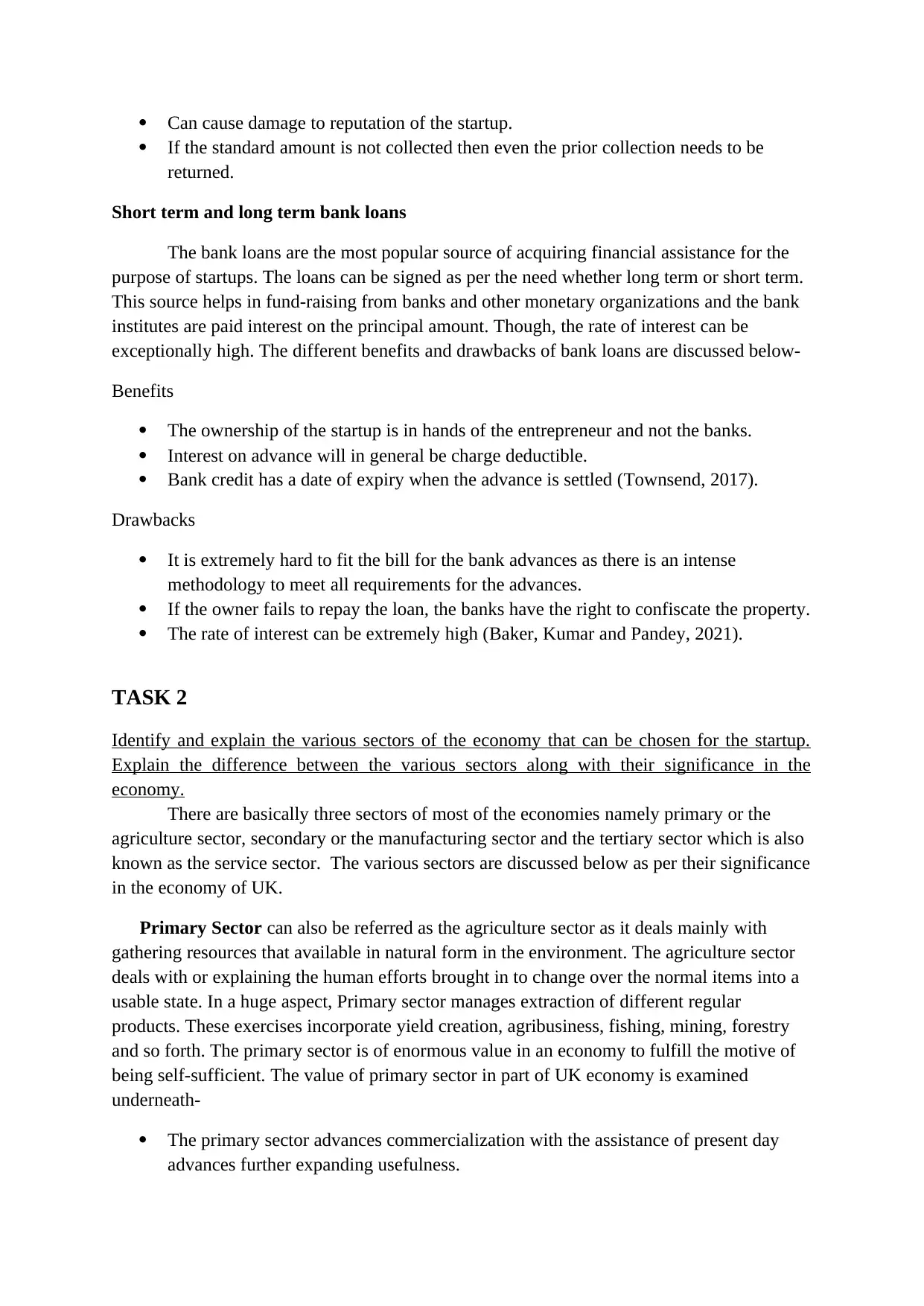
Can cause damage to reputation of the startup.
If the standard amount is not collected then even the prior collection needs to be
returned.
Short term and long term bank loans
The bank loans are the most popular source of acquiring financial assistance for the
purpose of startups. The loans can be signed as per the need whether long term or short term.
This source helps in fund-raising from banks and other monetary organizations and the bank
institutes are paid interest on the principal amount. Though, the rate of interest can be
exceptionally high. The different benefits and drawbacks of bank loans are discussed below-
Benefits
The ownership of the startup is in hands of the entrepreneur and not the banks.
Interest on advance will in general be charge deductible.
Bank credit has a date of expiry when the advance is settled (Townsend, 2017).
Drawbacks
It is extremely hard to fit the bill for the bank advances as there is an intense
methodology to meet all requirements for the advances.
If the owner fails to repay the loan, the banks have the right to confiscate the property.
The rate of interest can be extremely high (Baker, Kumar and Pandey, 2021).
TASK 2
Identify and explain the various sectors of the economy that can be chosen for the startup.
Explain the difference between the various sectors along with their significance in the
economy.
There are basically three sectors of most of the economies namely primary or the
agriculture sector, secondary or the manufacturing sector and the tertiary sector which is also
known as the service sector. The various sectors are discussed below as per their significance
in the economy of UK.
Primary Sector can also be referred as the agriculture sector as it deals mainly with
gathering resources that available in natural form in the environment. The agriculture sector
deals with or explaining the human efforts brought in to change over the normal items into a
usable state. In a huge aspect, Primary sector manages extraction of different regular
products. These exercises incorporate yield creation, agribusiness, fishing, mining, forestry
and so forth. The primary sector is of enormous value in an economy to fulfill the motive of
being self-sufficient. The value of primary sector in part of UK economy is examined
underneath-
The primary sector advances commercialization with the assistance of present day
advances further expanding usefulness.
If the standard amount is not collected then even the prior collection needs to be
returned.
Short term and long term bank loans
The bank loans are the most popular source of acquiring financial assistance for the
purpose of startups. The loans can be signed as per the need whether long term or short term.
This source helps in fund-raising from banks and other monetary organizations and the bank
institutes are paid interest on the principal amount. Though, the rate of interest can be
exceptionally high. The different benefits and drawbacks of bank loans are discussed below-
Benefits
The ownership of the startup is in hands of the entrepreneur and not the banks.
Interest on advance will in general be charge deductible.
Bank credit has a date of expiry when the advance is settled (Townsend, 2017).
Drawbacks
It is extremely hard to fit the bill for the bank advances as there is an intense
methodology to meet all requirements for the advances.
If the owner fails to repay the loan, the banks have the right to confiscate the property.
The rate of interest can be extremely high (Baker, Kumar and Pandey, 2021).
TASK 2
Identify and explain the various sectors of the economy that can be chosen for the startup.
Explain the difference between the various sectors along with their significance in the
economy.
There are basically three sectors of most of the economies namely primary or the
agriculture sector, secondary or the manufacturing sector and the tertiary sector which is also
known as the service sector. The various sectors are discussed below as per their significance
in the economy of UK.
Primary Sector can also be referred as the agriculture sector as it deals mainly with
gathering resources that available in natural form in the environment. The agriculture sector
deals with or explaining the human efforts brought in to change over the normal items into a
usable state. In a huge aspect, Primary sector manages extraction of different regular
products. These exercises incorporate yield creation, agribusiness, fishing, mining, forestry
and so forth. The primary sector is of enormous value in an economy to fulfill the motive of
being self-sufficient. The value of primary sector in part of UK economy is examined
underneath-
The primary sector advances commercialization with the assistance of present day
advances further expanding usefulness.
⊘ This is a preview!⊘
Do you want full access?
Subscribe today to unlock all pages.

Trusted by 1+ million students worldwide
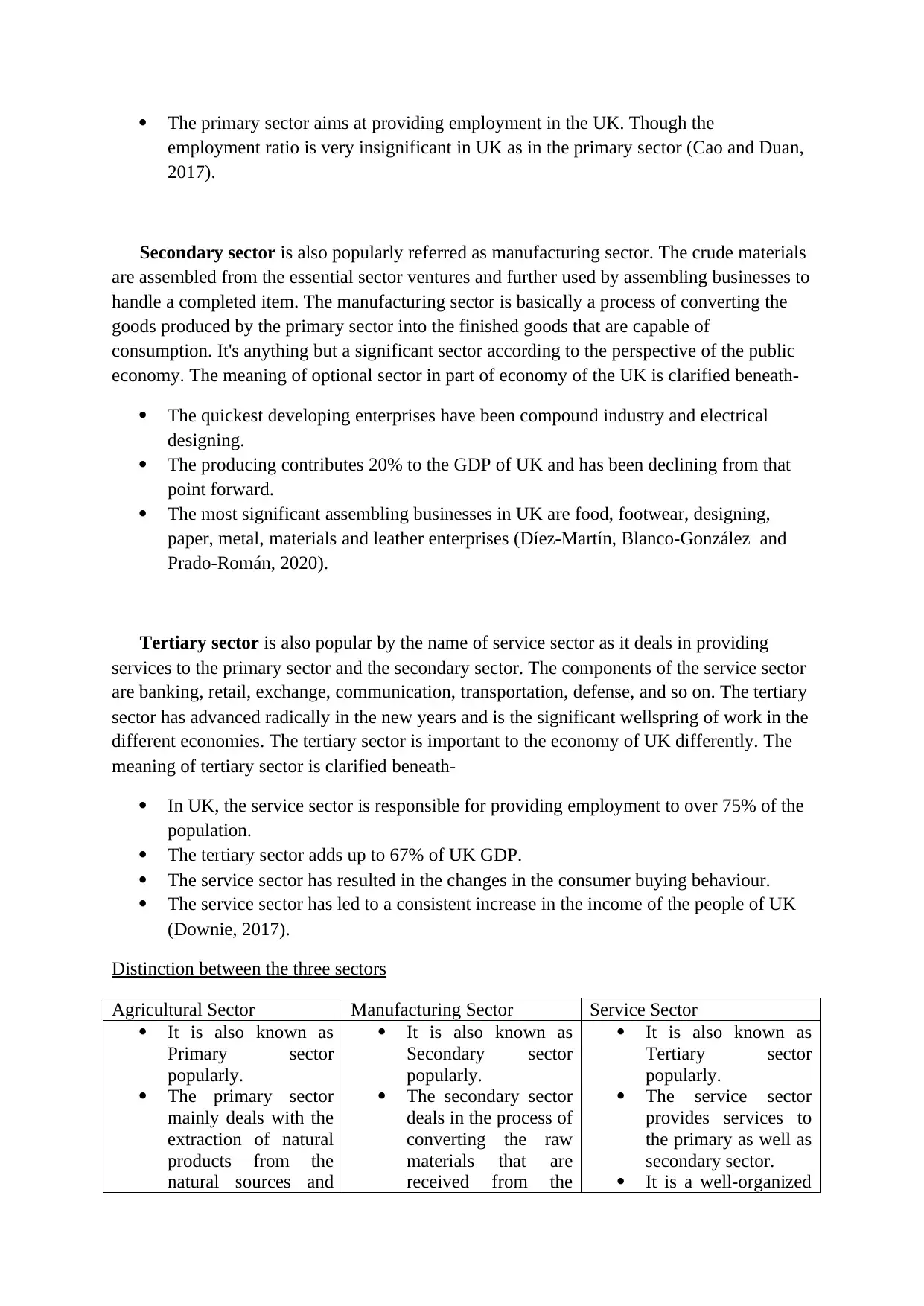
The primary sector aims at providing employment in the UK. Though the
employment ratio is very insignificant in UK as in the primary sector (Cao and Duan,
2017).
Secondary sector is also popularly referred as manufacturing sector. The crude materials
are assembled from the essential sector ventures and further used by assembling businesses to
handle a completed item. The manufacturing sector is basically a process of converting the
goods produced by the primary sector into the finished goods that are capable of
consumption. It's anything but a significant sector according to the perspective of the public
economy. The meaning of optional sector in part of economy of the UK is clarified beneath-
The quickest developing enterprises have been compound industry and electrical
designing.
The producing contributes 20% to the GDP of UK and has been declining from that
point forward.
The most significant assembling businesses in UK are food, footwear, designing,
paper, metal, materials and leather enterprises (Díez-Martín, Blanco-González and
Prado-Román, 2020).
Tertiary sector is also popular by the name of service sector as it deals in providing
services to the primary sector and the secondary sector. The components of the service sector
are banking, retail, exchange, communication, transportation, defense, and so on. The tertiary
sector has advanced radically in the new years and is the significant wellspring of work in the
different economies. The tertiary sector is important to the economy of UK differently. The
meaning of tertiary sector is clarified beneath-
In UK, the service sector is responsible for providing employment to over 75% of the
population.
The tertiary sector adds up to 67% of UK GDP.
The service sector has resulted in the changes in the consumer buying behaviour.
The service sector has led to a consistent increase in the income of the people of UK
(Downie, 2017).
Distinction between the three sectors
Agricultural Sector Manufacturing Sector Service Sector
It is also known as
Primary sector
popularly.
The primary sector
mainly deals with the
extraction of natural
products from the
natural sources and
It is also known as
Secondary sector
popularly.
The secondary sector
deals in the process of
converting the raw
materials that are
received from the
It is also known as
Tertiary sector
popularly.
The service sector
provides services to
the primary as well as
secondary sector.
It is a well-organized
employment ratio is very insignificant in UK as in the primary sector (Cao and Duan,
2017).
Secondary sector is also popularly referred as manufacturing sector. The crude materials
are assembled from the essential sector ventures and further used by assembling businesses to
handle a completed item. The manufacturing sector is basically a process of converting the
goods produced by the primary sector into the finished goods that are capable of
consumption. It's anything but a significant sector according to the perspective of the public
economy. The meaning of optional sector in part of economy of the UK is clarified beneath-
The quickest developing enterprises have been compound industry and electrical
designing.
The producing contributes 20% to the GDP of UK and has been declining from that
point forward.
The most significant assembling businesses in UK are food, footwear, designing,
paper, metal, materials and leather enterprises (Díez-Martín, Blanco-González and
Prado-Román, 2020).
Tertiary sector is also popular by the name of service sector as it deals in providing
services to the primary sector and the secondary sector. The components of the service sector
are banking, retail, exchange, communication, transportation, defense, and so on. The tertiary
sector has advanced radically in the new years and is the significant wellspring of work in the
different economies. The tertiary sector is important to the economy of UK differently. The
meaning of tertiary sector is clarified beneath-
In UK, the service sector is responsible for providing employment to over 75% of the
population.
The tertiary sector adds up to 67% of UK GDP.
The service sector has resulted in the changes in the consumer buying behaviour.
The service sector has led to a consistent increase in the income of the people of UK
(Downie, 2017).
Distinction between the three sectors
Agricultural Sector Manufacturing Sector Service Sector
It is also known as
Primary sector
popularly.
The primary sector
mainly deals with the
extraction of natural
products from the
natural sources and
It is also known as
Secondary sector
popularly.
The secondary sector
deals in the process of
converting the raw
materials that are
received from the
It is also known as
Tertiary sector
popularly.
The service sector
provides services to
the primary as well as
secondary sector.
It is a well-organized
Paraphrase This Document
Need a fresh take? Get an instant paraphrase of this document with our AI Paraphraser
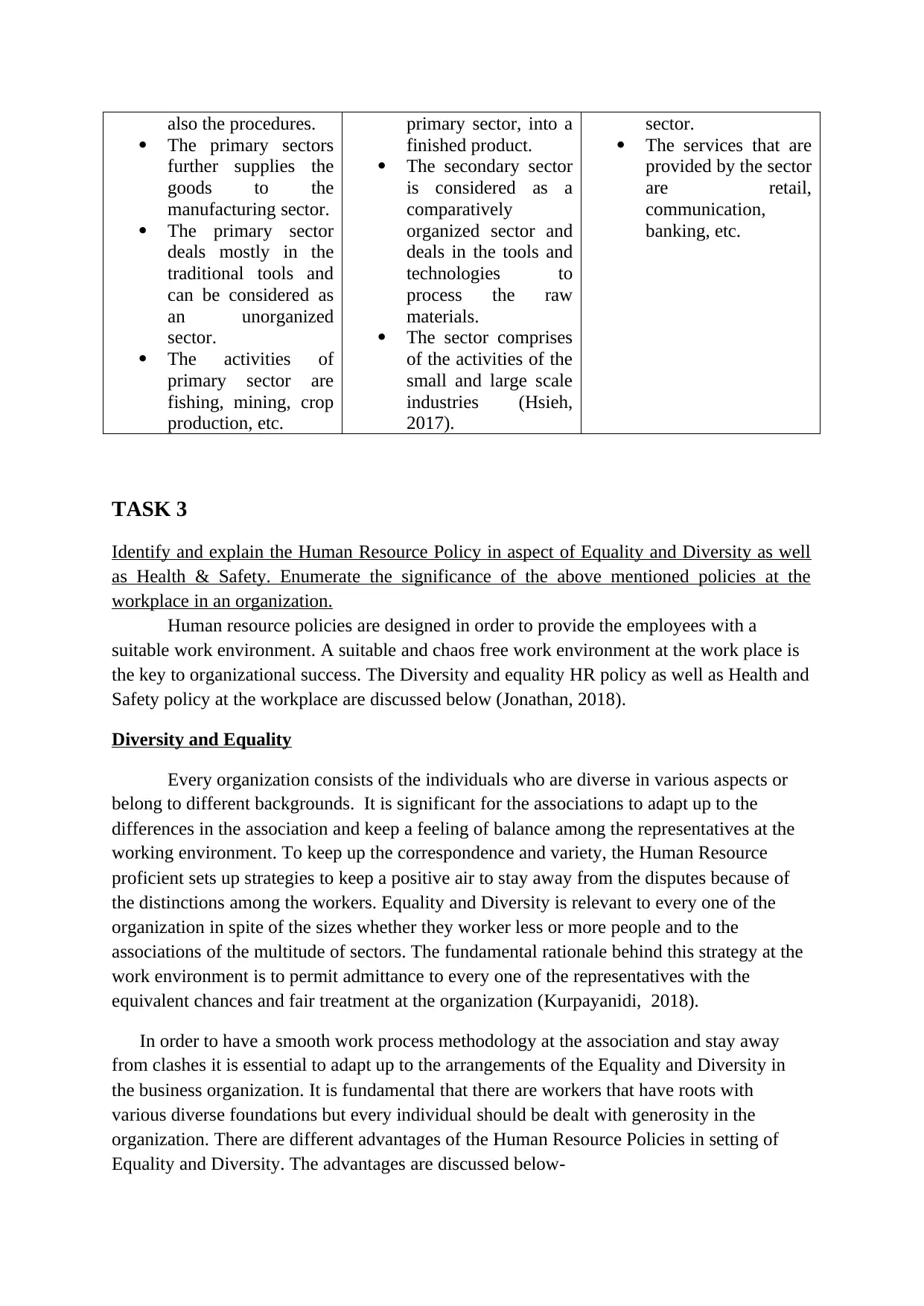
also the procedures.
The primary sectors
further supplies the
goods to the
manufacturing sector.
The primary sector
deals mostly in the
traditional tools and
can be considered as
an unorganized
sector.
The activities of
primary sector are
fishing, mining, crop
production, etc.
primary sector, into a
finished product.
The secondary sector
is considered as a
comparatively
organized sector and
deals in the tools and
technologies to
process the raw
materials.
The sector comprises
of the activities of the
small and large scale
industries (Hsieh,
2017).
sector.
The services that are
provided by the sector
are retail,
communication,
banking, etc.
TASK 3
Identify and explain the Human Resource Policy in aspect of Equality and Diversity as well
as Health & Safety. Enumerate the significance of the above mentioned policies at the
workplace in an organization.
Human resource policies are designed in order to provide the employees with a
suitable work environment. A suitable and chaos free work environment at the work place is
the key to organizational success. The Diversity and equality HR policy as well as Health and
Safety policy at the workplace are discussed below (Jonathan, 2018).
Diversity and Equality
Every organization consists of the individuals who are diverse in various aspects or
belong to different backgrounds. It is significant for the associations to adapt up to the
differences in the association and keep a feeling of balance among the representatives at the
working environment. To keep up the correspondence and variety, the Human Resource
proficient sets up strategies to keep a positive air to stay away from the disputes because of
the distinctions among the workers. Equality and Diversity is relevant to every one of the
organization in spite of the sizes whether they worker less or more people and to the
associations of the multitude of sectors. The fundamental rationale behind this strategy at the
work environment is to permit admittance to every one of the representatives with the
equivalent chances and fair treatment at the organization (Kurpayanidi, 2018).
In order to have a smooth work process methodology at the association and stay away
from clashes it is essential to adapt up to the arrangements of the Equality and Diversity in
the business organization. It is fundamental that there are workers that have roots with
various diverse foundations but every individual should be dealt with generosity in the
organization. There are different advantages of the Human Resource Policies in setting of
Equality and Diversity. The advantages are discussed below-
The primary sectors
further supplies the
goods to the
manufacturing sector.
The primary sector
deals mostly in the
traditional tools and
can be considered as
an unorganized
sector.
The activities of
primary sector are
fishing, mining, crop
production, etc.
primary sector, into a
finished product.
The secondary sector
is considered as a
comparatively
organized sector and
deals in the tools and
technologies to
process the raw
materials.
The sector comprises
of the activities of the
small and large scale
industries (Hsieh,
2017).
sector.
The services that are
provided by the sector
are retail,
communication,
banking, etc.
TASK 3
Identify and explain the Human Resource Policy in aspect of Equality and Diversity as well
as Health & Safety. Enumerate the significance of the above mentioned policies at the
workplace in an organization.
Human resource policies are designed in order to provide the employees with a
suitable work environment. A suitable and chaos free work environment at the work place is
the key to organizational success. The Diversity and equality HR policy as well as Health and
Safety policy at the workplace are discussed below (Jonathan, 2018).
Diversity and Equality
Every organization consists of the individuals who are diverse in various aspects or
belong to different backgrounds. It is significant for the associations to adapt up to the
differences in the association and keep a feeling of balance among the representatives at the
working environment. To keep up the correspondence and variety, the Human Resource
proficient sets up strategies to keep a positive air to stay away from the disputes because of
the distinctions among the workers. Equality and Diversity is relevant to every one of the
organization in spite of the sizes whether they worker less or more people and to the
associations of the multitude of sectors. The fundamental rationale behind this strategy at the
work environment is to permit admittance to every one of the representatives with the
equivalent chances and fair treatment at the organization (Kurpayanidi, 2018).
In order to have a smooth work process methodology at the association and stay away
from clashes it is essential to adapt up to the arrangements of the Equality and Diversity in
the business organization. It is fundamental that there are workers that have roots with
various diverse foundations but every individual should be dealt with generosity in the
organization. There are different advantages of the Human Resource Policies in setting of
Equality and Diversity. The advantages are discussed below-
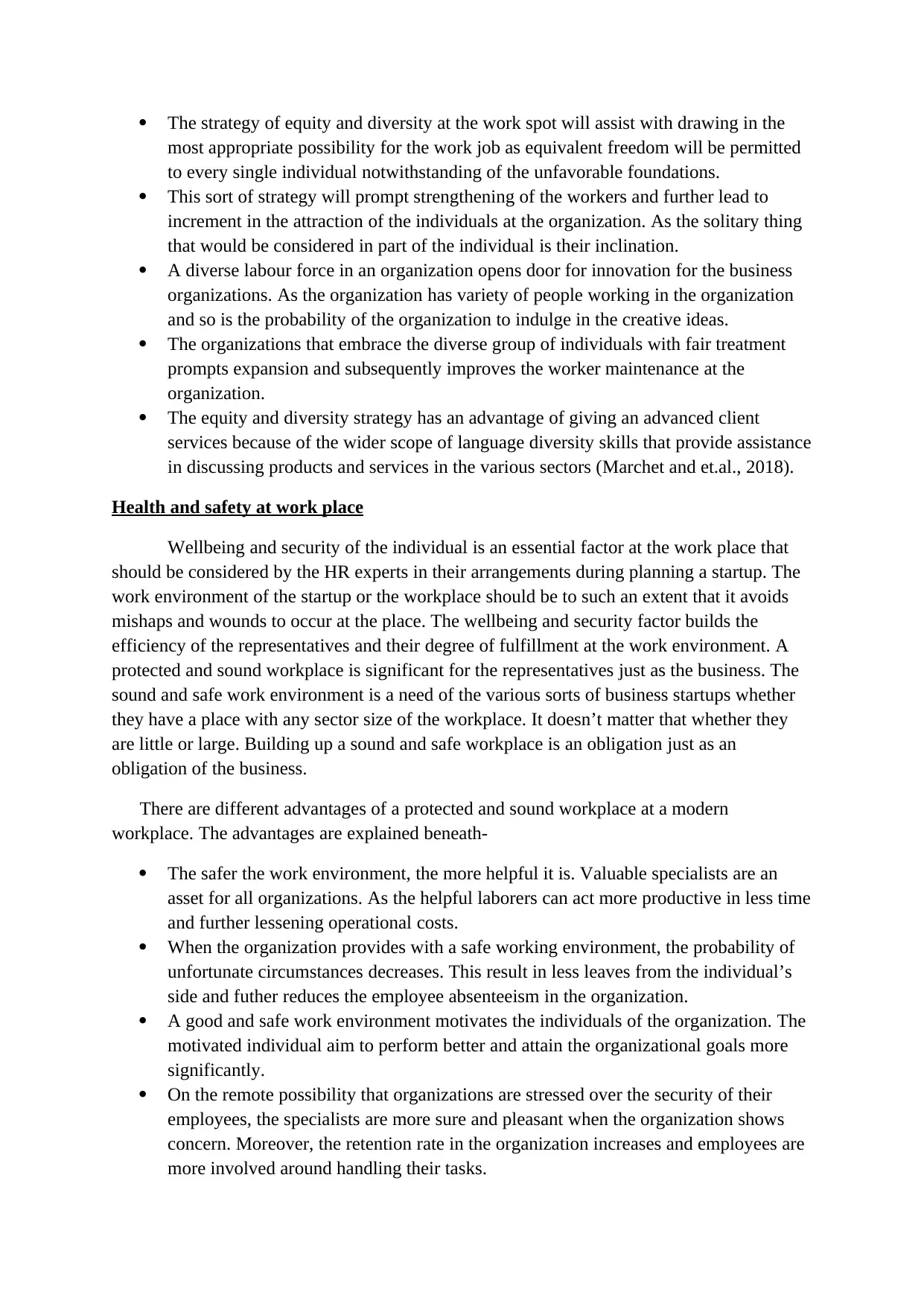
The strategy of equity and diversity at the work spot will assist with drawing in the
most appropriate possibility for the work job as equivalent freedom will be permitted
to every single individual notwithstanding of the unfavorable foundations.
This sort of strategy will prompt strengthening of the workers and further lead to
increment in the attraction of the individuals at the organization. As the solitary thing
that would be considered in part of the individual is their inclination.
A diverse labour force in an organization opens door for innovation for the business
organizations. As the organization has variety of people working in the organization
and so is the probability of the organization to indulge in the creative ideas.
The organizations that embrace the diverse group of individuals with fair treatment
prompts expansion and subsequently improves the worker maintenance at the
organization.
The equity and diversity strategy has an advantage of giving an advanced client
services because of the wider scope of language diversity skills that provide assistance
in discussing products and services in the various sectors (Marchet and et.al., 2018).
Health and safety at work place
Wellbeing and security of the individual is an essential factor at the work place that
should be considered by the HR experts in their arrangements during planning a startup. The
work environment of the startup or the workplace should be to such an extent that it avoids
mishaps and wounds to occur at the place. The wellbeing and security factor builds the
efficiency of the representatives and their degree of fulfillment at the work environment. A
protected and sound workplace is significant for the representatives just as the business. The
sound and safe work environment is a need of the various sorts of business startups whether
they have a place with any sector size of the workplace. It doesn’t matter that whether they
are little or large. Building up a sound and safe workplace is an obligation just as an
obligation of the business.
There are different advantages of a protected and sound workplace at a modern
workplace. The advantages are explained beneath-
The safer the work environment, the more helpful it is. Valuable specialists are an
asset for all organizations. As the helpful laborers can act more productive in less time
and further lessening operational costs.
When the organization provides with a safe working environment, the probability of
unfortunate circumstances decreases. This result in less leaves from the individual’s
side and futher reduces the employee absenteeism in the organization.
A good and safe work environment motivates the individuals of the organization. The
motivated individual aim to perform better and attain the organizational goals more
significantly.
On the remote possibility that organizations are stressed over the security of their
employees, the specialists are more sure and pleasant when the organization shows
concern. Moreover, the retention rate in the organization increases and employees are
more involved around handling their tasks.
most appropriate possibility for the work job as equivalent freedom will be permitted
to every single individual notwithstanding of the unfavorable foundations.
This sort of strategy will prompt strengthening of the workers and further lead to
increment in the attraction of the individuals at the organization. As the solitary thing
that would be considered in part of the individual is their inclination.
A diverse labour force in an organization opens door for innovation for the business
organizations. As the organization has variety of people working in the organization
and so is the probability of the organization to indulge in the creative ideas.
The organizations that embrace the diverse group of individuals with fair treatment
prompts expansion and subsequently improves the worker maintenance at the
organization.
The equity and diversity strategy has an advantage of giving an advanced client
services because of the wider scope of language diversity skills that provide assistance
in discussing products and services in the various sectors (Marchet and et.al., 2018).
Health and safety at work place
Wellbeing and security of the individual is an essential factor at the work place that
should be considered by the HR experts in their arrangements during planning a startup. The
work environment of the startup or the workplace should be to such an extent that it avoids
mishaps and wounds to occur at the place. The wellbeing and security factor builds the
efficiency of the representatives and their degree of fulfillment at the work environment. A
protected and sound workplace is significant for the representatives just as the business. The
sound and safe work environment is a need of the various sorts of business startups whether
they have a place with any sector size of the workplace. It doesn’t matter that whether they
are little or large. Building up a sound and safe workplace is an obligation just as an
obligation of the business.
There are different advantages of a protected and sound workplace at a modern
workplace. The advantages are explained beneath-
The safer the work environment, the more helpful it is. Valuable specialists are an
asset for all organizations. As the helpful laborers can act more productive in less time
and further lessening operational costs.
When the organization provides with a safe working environment, the probability of
unfortunate circumstances decreases. This result in less leaves from the individual’s
side and futher reduces the employee absenteeism in the organization.
A good and safe work environment motivates the individuals of the organization. The
motivated individual aim to perform better and attain the organizational goals more
significantly.
On the remote possibility that organizations are stressed over the security of their
employees, the specialists are more sure and pleasant when the organization shows
concern. Moreover, the retention rate in the organization increases and employees are
more involved around handling their tasks.
⊘ This is a preview!⊘
Do you want full access?
Subscribe today to unlock all pages.

Trusted by 1+ million students worldwide
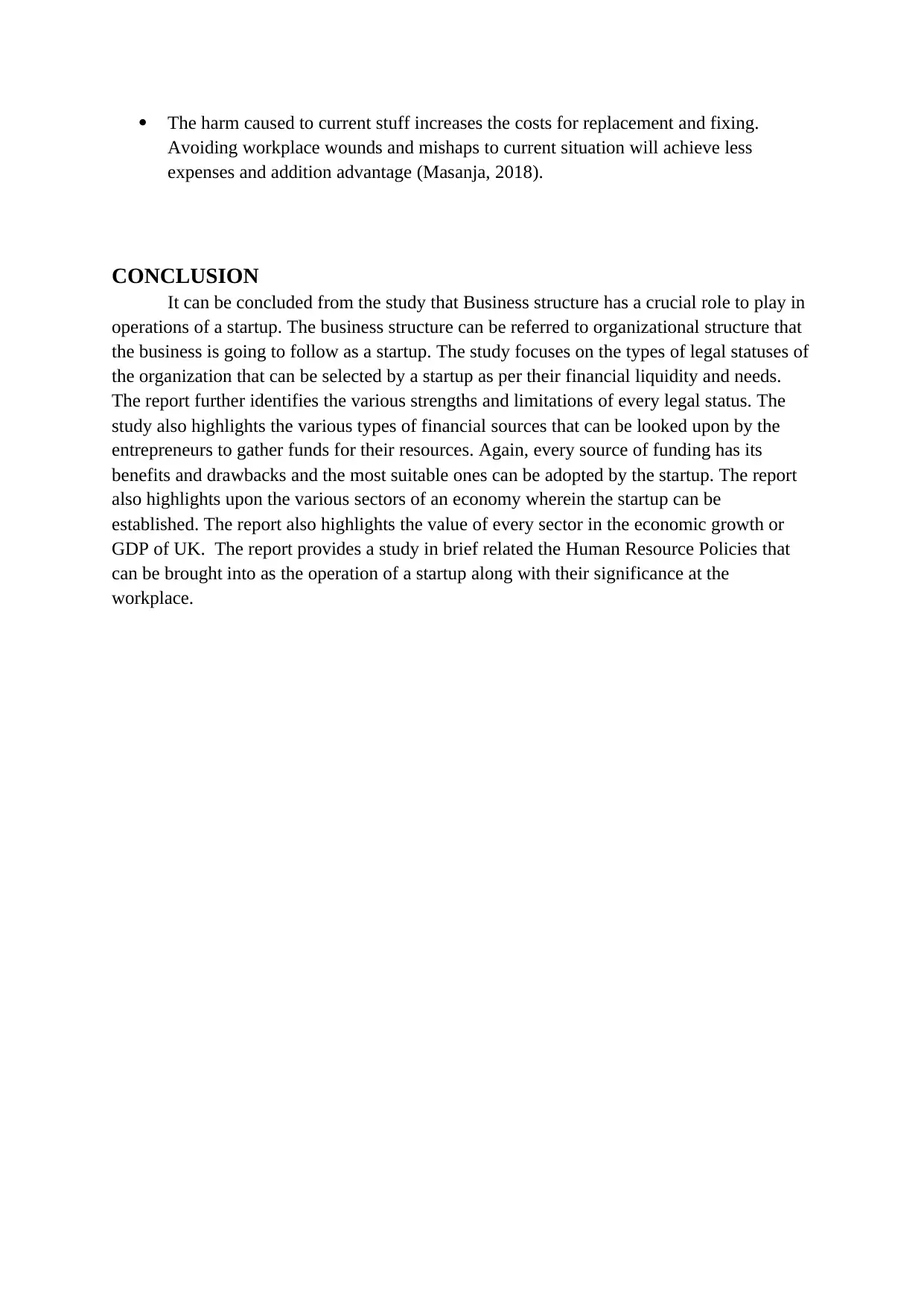
The harm caused to current stuff increases the costs for replacement and fixing.
Avoiding workplace wounds and mishaps to current situation will achieve less
expenses and addition advantage (Masanja, 2018).
CONCLUSION
It can be concluded from the study that Business structure has a crucial role to play in
operations of a startup. The business structure can be referred to organizational structure that
the business is going to follow as a startup. The study focuses on the types of legal statuses of
the organization that can be selected by a startup as per their financial liquidity and needs.
The report further identifies the various strengths and limitations of every legal status. The
study also highlights the various types of financial sources that can be looked upon by the
entrepreneurs to gather funds for their resources. Again, every source of funding has its
benefits and drawbacks and the most suitable ones can be adopted by the startup. The report
also highlights upon the various sectors of an economy wherein the startup can be
established. The report also highlights the value of every sector in the economic growth or
GDP of UK. The report provides a study in brief related the Human Resource Policies that
can be brought into as the operation of a startup along with their significance at the
workplace.
Avoiding workplace wounds and mishaps to current situation will achieve less
expenses and addition advantage (Masanja, 2018).
CONCLUSION
It can be concluded from the study that Business structure has a crucial role to play in
operations of a startup. The business structure can be referred to organizational structure that
the business is going to follow as a startup. The study focuses on the types of legal statuses of
the organization that can be selected by a startup as per their financial liquidity and needs.
The report further identifies the various strengths and limitations of every legal status. The
study also highlights the various types of financial sources that can be looked upon by the
entrepreneurs to gather funds for their resources. Again, every source of funding has its
benefits and drawbacks and the most suitable ones can be adopted by the startup. The report
also highlights upon the various sectors of an economy wherein the startup can be
established. The report also highlights the value of every sector in the economic growth or
GDP of UK. The report provides a study in brief related the Human Resource Policies that
can be brought into as the operation of a startup along with their significance at the
workplace.
Paraphrase This Document
Need a fresh take? Get an instant paraphrase of this document with our AI Paraphraser
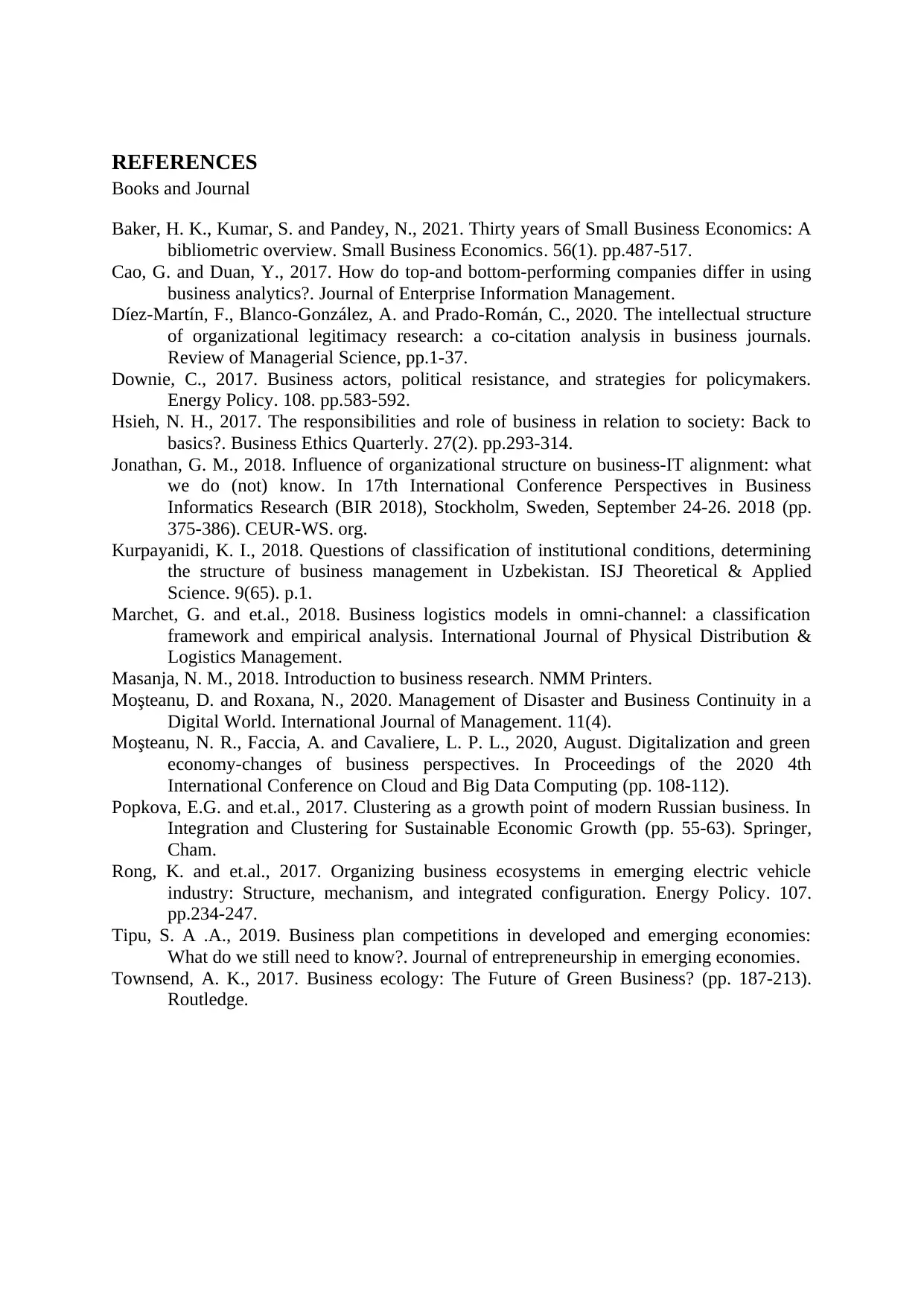
REFERENCES
Books and Journal
Baker, H. K., Kumar, S. and Pandey, N., 2021. Thirty years of Small Business Economics: A
bibliometric overview. Small Business Economics. 56(1). pp.487-517.
Cao, G. and Duan, Y., 2017. How do top-and bottom-performing companies differ in using
business analytics?. Journal of Enterprise Information Management.
Díez-Martín, F., Blanco-González, A. and Prado-Román, C., 2020. The intellectual structure
of organizational legitimacy research: a co-citation analysis in business journals.
Review of Managerial Science, pp.1-37.
Downie, C., 2017. Business actors, political resistance, and strategies for policymakers.
Energy Policy. 108. pp.583-592.
Hsieh, N. H., 2017. The responsibilities and role of business in relation to society: Back to
basics?. Business Ethics Quarterly. 27(2). pp.293-314.
Jonathan, G. M., 2018. Influence of organizational structure on business-IT alignment: what
we do (not) know. In 17th International Conference Perspectives in Business
Informatics Research (BIR 2018), Stockholm, Sweden, September 24-26. 2018 (pp.
375-386). CEUR-WS. org.
Kurpayanidi, K. I., 2018. Questions of classification of institutional conditions, determining
the structure of business management in Uzbekistan. ISJ Theoretical & Applied
Science. 9(65). p.1.
Marchet, G. and et.al., 2018. Business logistics models in omni-channel: a classification
framework and empirical analysis. International Journal of Physical Distribution &
Logistics Management.
Masanja, N. M., 2018. Introduction to business research. NMM Printers.
Moşteanu, D. and Roxana, N., 2020. Management of Disaster and Business Continuity in a
Digital World. International Journal of Management. 11(4).
Moşteanu, N. R., Faccia, A. and Cavaliere, L. P. L., 2020, August. Digitalization and green
economy-changes of business perspectives. In Proceedings of the 2020 4th
International Conference on Cloud and Big Data Computing (pp. 108-112).
Popkova, E.G. and et.al., 2017. Clustering as a growth point of modern Russian business. In
Integration and Clustering for Sustainable Economic Growth (pp. 55-63). Springer,
Cham.
Rong, K. and et.al., 2017. Organizing business ecosystems in emerging electric vehicle
industry: Structure, mechanism, and integrated configuration. Energy Policy. 107.
pp.234-247.
Tipu, S. A .A., 2019. Business plan competitions in developed and emerging economies:
What do we still need to know?. Journal of entrepreneurship in emerging economies.
Townsend, A. K., 2017. Business ecology: The Future of Green Business? (pp. 187-213).
Routledge.
Books and Journal
Baker, H. K., Kumar, S. and Pandey, N., 2021. Thirty years of Small Business Economics: A
bibliometric overview. Small Business Economics. 56(1). pp.487-517.
Cao, G. and Duan, Y., 2017. How do top-and bottom-performing companies differ in using
business analytics?. Journal of Enterprise Information Management.
Díez-Martín, F., Blanco-González, A. and Prado-Román, C., 2020. The intellectual structure
of organizational legitimacy research: a co-citation analysis in business journals.
Review of Managerial Science, pp.1-37.
Downie, C., 2017. Business actors, political resistance, and strategies for policymakers.
Energy Policy. 108. pp.583-592.
Hsieh, N. H., 2017. The responsibilities and role of business in relation to society: Back to
basics?. Business Ethics Quarterly. 27(2). pp.293-314.
Jonathan, G. M., 2018. Influence of organizational structure on business-IT alignment: what
we do (not) know. In 17th International Conference Perspectives in Business
Informatics Research (BIR 2018), Stockholm, Sweden, September 24-26. 2018 (pp.
375-386). CEUR-WS. org.
Kurpayanidi, K. I., 2018. Questions of classification of institutional conditions, determining
the structure of business management in Uzbekistan. ISJ Theoretical & Applied
Science. 9(65). p.1.
Marchet, G. and et.al., 2018. Business logistics models in omni-channel: a classification
framework and empirical analysis. International Journal of Physical Distribution &
Logistics Management.
Masanja, N. M., 2018. Introduction to business research. NMM Printers.
Moşteanu, D. and Roxana, N., 2020. Management of Disaster and Business Continuity in a
Digital World. International Journal of Management. 11(4).
Moşteanu, N. R., Faccia, A. and Cavaliere, L. P. L., 2020, August. Digitalization and green
economy-changes of business perspectives. In Proceedings of the 2020 4th
International Conference on Cloud and Big Data Computing (pp. 108-112).
Popkova, E.G. and et.al., 2017. Clustering as a growth point of modern Russian business. In
Integration and Clustering for Sustainable Economic Growth (pp. 55-63). Springer,
Cham.
Rong, K. and et.al., 2017. Organizing business ecosystems in emerging electric vehicle
industry: Structure, mechanism, and integrated configuration. Energy Policy. 107.
pp.234-247.
Tipu, S. A .A., 2019. Business plan competitions in developed and emerging economies:
What do we still need to know?. Journal of entrepreneurship in emerging economies.
Townsend, A. K., 2017. Business ecology: The Future of Green Business? (pp. 187-213).
Routledge.
1 out of 11
Related Documents
Your All-in-One AI-Powered Toolkit for Academic Success.
+13062052269
info@desklib.com
Available 24*7 on WhatsApp / Email
![[object Object]](/_next/static/media/star-bottom.7253800d.svg)
Unlock your academic potential
Copyright © 2020–2025 A2Z Services. All Rights Reserved. Developed and managed by ZUCOL.





